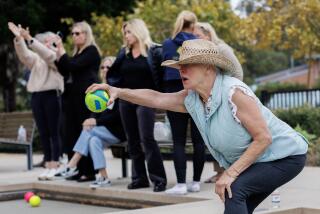DISCOVERY : Newport Harbor Lawn Bowling Club
- Share via
In an edict issued by King Henry VIII of England in 1511, the game of bowles, as it was then called, was denounced as an evil associated with gambling, saloons and dissolute places. Did he mean lawn bowling? That sedate game played by septuagenarians clad in natty dress whites?
At the Newport Harbor Lawn Bowling Club in Corona del Mar, most members may be past retirement age, but sedate they are not.
“We want more youngsters to join,” says 94-year-old Al Morrison, who has been playing the game since 1962. “I hate to see young people sitting around letting themselves get out of shape. There’s no excuse for it.”
To Morrison, the term young means anyone under 60. However, the average age for world champions is 35. Only in the United States do most of the players take up lawn bowling after retirement.
“Living in Orange County, people don’t think they have the time to learn the sport,” Morrison said. “We want kids and families and retirees to come out here and take up the game. It’s a great way to spend an afternoon together. Besides, we need some new blood.” Some of Morrison’s more cynical friends insist that he simply needs someone new to beat.
The facility is situated in San Joaquin Hills Park, where it shares space with four tennis courts.
Morrison says the game attracts a variety of enthusiasts from other sports. “I think tennis buffs are attracted to the precision aspect of the game,” Morrison said. “For golfers, lawn bowling is equivalent to putting, except someone keeps moving or blocking the hole. It’s a fun game, but it is not easy. “
There is a lot more laughing on the rink than on a golf course or tennis court. It also costs much less to lawn bowl than to play a round of golf.
To promote the game, the club offers free lessons to visitors. Just walk in through the gate, take a seat on a rinkside bench and one of the club’s 130 members will sit down and explain how the age-old game (its roots can be traced as far back as 5200 BC), is played.
The sport is played on a closely cropped lawn. Competitors roll four 3 1/2-pound bowls within designated lanes, or rinks, toward a smaller white target ball called a jack. Points are scored by those players, or teams, whose bowls come to rest nearest the jack. At the end of 14 turns, or ins , whoever has the most points wins. It all sounds simple enough, but the bowls are not perfectly round but rather weighted on one side so that they roll on a bias.
“There are no straight lines in lawn bowling,” explained Tag Taggart, an avid lawn bowler and Coast Community College lawn bowling instructor. “Strategy comes into play when one player blocks out another or knocks the jack from a tightly grouped set of bowls.”
As for exercise, a lawn bowler will walk more than a mile during a 14-turn match, and the hips and joints will be in constant use.
Yet if you ask most of these bowlers why they play, the majority will respond that competition is the chief reason. A large part of the gamesmanship in lawn bowling includes tactics such as the well-timed cough, positioning oneself a smidgen closer to the jack or offering unsolicited advice.
“I like to tell my opponents what they did wrong,” Morrison says. Then, with a sly wink, he adds: “Sometimes I even tell them the truth.”
Perhaps King Henry VIII was right.


